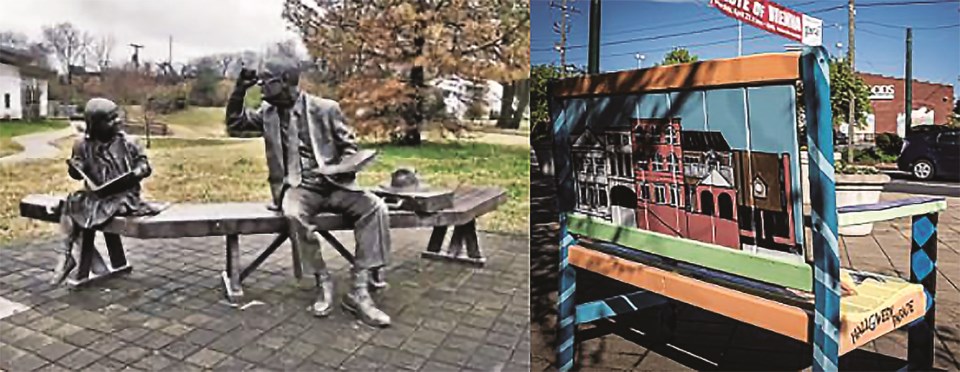The Vienna Public Art Commission hopes to expand considerably the town’s art offerings and make Vienna more attractive and engaging to residents, businesses and visitors alike.
But the commission is doing more than just idly dreaming. The Vienna Town Council on March 20 unanimously approved the group’s 38-page “Vision for Public Art Master Plan,” which outlined dozens of ways of making the town more aesthetically pleasing and suggested where the improvements could be implemented.
With that initial objective out of the way, the commission now will work to improve existing public art, develop new projects, accelerate their installation and raise the commission’s profile.
The Council started the commission in 2017 and appointed its initial seven members for two-year terms. The group’s charge is to integrate seamlessly public art with the town.
“Installations of public art that reflect our town’s identity not only have the potential to become iconic, but they can be a moment of education and solidarity, demonstrate both economic wealth and vitality, and attract more businesses and people,” the master plan read.
The commission already has begun apply elements of the plan to its current projects.
“So far, our master-plan blueprint is working wonderfully,” said commission chairman Michael Cheselka.
The commission’s plan identifies eight areas for public-art projects:
• Area 1, along four blocks of historic Church Street, now features storm-drain paintings sponsored by the commission.
Other art possibilities for this zone include mosaics; artistically enhanced benches; district-defining signage, banners and posts; and murals along building walls or fence façades.
• Area 2 includes light-industrial and transitional areas and focuses primarily on the Mill District, which runs from the northernmost end of Mill Street, N.E., to Church Street and one block west to Dominion Road, N.E. This area now has a railroad-themed mural painted more than two decades ago on the wall of a business across from the historic train station.
The commission’s plan suggests this district also could be home to streetlight displays, LED banners, creative bike racks and artistically enhanced lampposts and/or streetlights.
• Area 3 pertains to parks, trails and recreational sites, such as the Town Green. Existing art in this zone includes the LOVE sign on the Washington & Old Dominion (W&OD) Regional Trail, the Town Green’s fountain, sidewalk storm-drain paintings and butterfly wings painted on the athletic-fields’ building near the Vienna Community Center.
Art possibilities for this district include multi-directional signposts (older television viewers might recall the one on “M*A*S*H”); sculptural artwork along walking or bicycle paths; and integrated functional or environmental artwork, such as sculptural seating.
Musical sculpture gardens are another option and the commission already is advancing plans for Harmony Park, which would be located near the red caboose along the W&OD in central Vienna.
Some residents worried about excessive noise from the flower-shaped instruments, each of which would make a different sound when struck. The commission has obtained the exact mallets park users would swing to get sounds from the flowers and will let the Council see the results firsthand on a field trip to a similar site, Cheselka said.
• Area 4 refers to gateways and entry points, which now are graced only by the town’s entry and exit signs.
Places within Area 4 could contain entry signage, statues and gates. The report cautions that because those viewing the art likely would be moving past in vehicles or on foot, the town would need to pay extra attention to the artistic elements’ scale and visibility.
• Area 5 consists of civic areas such as the town’s community center, police headquarters, Town Hall, Vienna Volunteer Fire Department and Patrick Henry Library.
The area now has the “Taking Flight” statue in front of the community center and a ground mural behind the building. There also are storm-drain murals on Park and Center streets.
Public-art possibilities within this area include regular art exhibitions at Town Hall, indoor installation works, landmark statues or “statement pieces,” commemorative or memorial compositions and artistic fountains.
• Area 6 applies to schools and there already is a sidewalk mural at Cunningham Park Elementary School. Artistic possibilities in this area include school-mascot stencils applied to trails and roads leading to the facility, enhanced sidewalks and crosswalks, water features, garden sculptures, and student contests to decorate garbage cans and dumpsters.
• Area 7 is Maple Avenue, the town’s primary commercial corridor. This area now is home to murals painted on a couple of businesses, but could be enhanced further with artistic street posts and more murals on commercial structures.
• Area 8 pertains to other town property, such as utility boxes, bus stops, storm drains and fire hydrants. The commission’s report suggested these elements could be enlivened with utility-pole artwork, sustainability-themed art on storm drains, artistic wraps around utility boxes, and murals on bus stops and fire hydrants.
Enhancements in all eight areas could be financed via town funding, private donations and grants obtained by the Vienna Public Art Foundation, the commission’s financial arm. The governments of Purcellville, Leesburg, Reston, Falls Church and Alexandria all have robust public-art programs, the report read.
Vienna officials could encourage developers to include public-art projects in their plans, as frequently is done in Tysons, and nurture voluntary projects undertaken by businesses and residents, according to the report.



